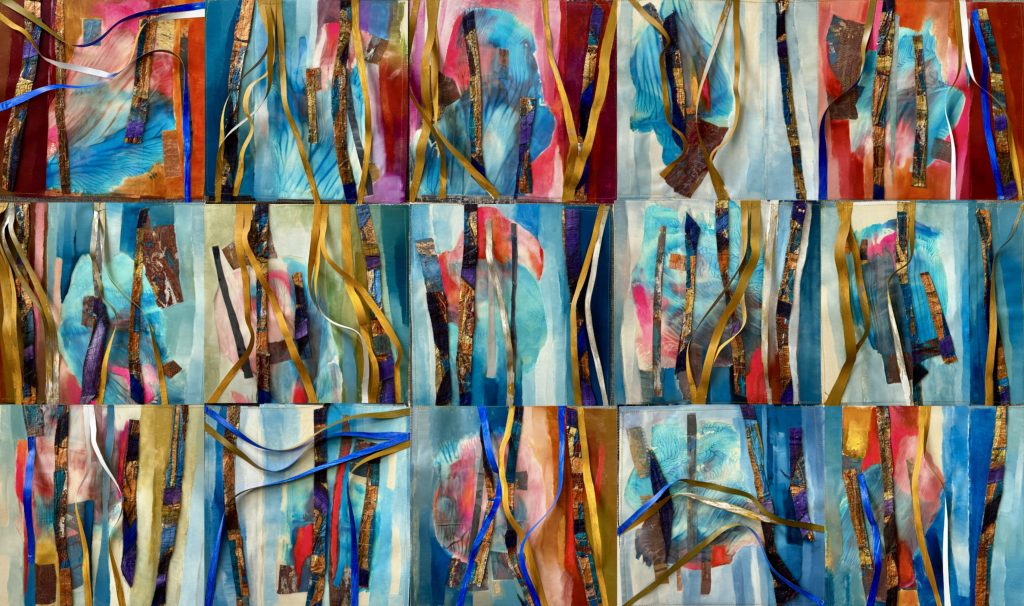Miguel Barros is a painter with the eyes of an architect and the heart of a gardener. Born in Lisbon in 1962, his life has spanned three continents—Europe, Africa, and North America—and these shifting landscapes shape his visual language. Holding citizenship in Portugal, Canada, and Angola, Barros carries with him not just passports, but stories. In 2014, he left Angola for Calgary, Alberta, where the wide skies and crisp light opened new doors to creativity. With a degree in Architecture and Design from IADE Lisbon (1984), he builds his art the way some build homes—carefully, structurally, but with poetic freedom. The result is a practice that blends discipline and emotion, earth and atmosphere.

His work Gardens of My Life reads like a quiet memory, or maybe a dream you forgot you had. A large-scale mixed media piece, 90 by 150 cm, it is built from upcycled materials arranged in the style of Portuguese azulejo tiles—those blue-and-white mosaics you find on ancient walls, now infused with a riot of color. But these aren’t decorative panels. They are a personal story laid bare.
Barros doesn’t paint scenes, he paints sensations. Gardens of My Life isn’t a garden in the usual sense. There are no literal flowers, no clean rows of tulips or trimmed hedges. Instead, the work pulses with fluid blue and red washes, sharp vertical strips, and winding ribbons that suggest motion—wind, maybe, or the sway of tall grass. It’s a collage of gestures. There’s a tension between control and spontaneity: sewn seams hold things in place, while curling ribbons defy the grid.
He describes this garden as a place of surrender, a secret path into “enchanted universes.” That tracks. The painting offers that same sense of immersion. The longer you look, the more you start to see forms that shift—like insects darting through leaves, or the flicker of light on a pond’s surface. The texture pulls you in. Strips of fabric, painted paper, possibly foil or bark-like material—each piece stitched or layered with care, yet never stiff. The work breathes.
There’s also a quiet spirituality to it. In his own words, Barros says the garden is where “love for life transforms into constant protection.” That idea—that we are part of nature, not above it—comes through in the piece. It’s not just admiration for the environment; it’s a call to merge with it. That line between observer and participant dissolves. You’re not looking at a garden. You’re inside it.
The mosaic structure matters too. By working with upcycled materials and assembling them like tiles, Barros ties his contemporary message to Portuguese cultural heritage. But he’s not being nostalgic—he’s reimagining tradition. Instead of ceramic, it’s cloth. Instead of fixed imagery, it’s abstraction. The message is subtle but pointed: even what is discarded can become beautiful, even what is fragmented can belong.
Barros’s architectural background plays a quiet role here. There’s a sense of rhythm in the way he organizes space, a kind of spatial awareness that allows chaos and harmony to coexist. Yet it’s never cold or cerebral. This is an emotional landscape. It speaks to longing—for home, for peace, for belonging. And it speaks to memory, but not just personal memory—shared memory, cultural memory, the kind passed down through textures, smells, wind.
What makes Gardens of My Life resonate is not just the visual impact, but the emotional clarity. Barros isn’t trying to impress with technique (though it’s there); he’s trying to connect. To remind us that even in this fractured world, beauty still finds a way through. In a time when so much feels disposable, he builds something lasting—out of scraps, out of softness, out of soul.
This is what Barros does best. He builds bridges between places, between ideas, between materials and meaning. Whether working in Calgary or Lisbon or Luanda, his garden always seems to follow him—and he invites us in, not to admire from afar, but to walk among its paths and feel what it means to be part of something alive.


